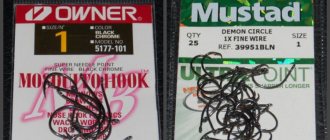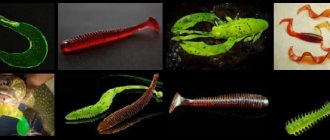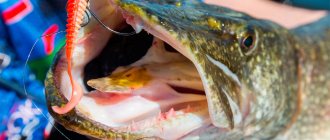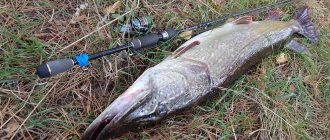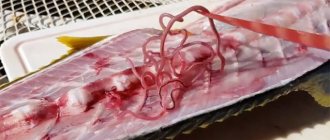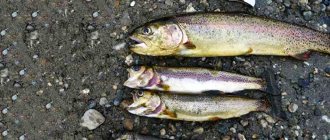Silicone worms are the most productive bait, almost always guaranteeing success when catching trout - regardless of rainbow or brook. And if the varieties of silicone baits listed in the previous part of the article have an advantage over numerous types of hard spinning baits, then among the entire range of soft baits, silicone worms are almost the most popular. By using the appropriate types of equipment, you can always count on the favor of trout, regardless of the degree of its activity and location in the reservoir. And, of course, it is possible to successfully fish both in rivers with strong currents and on pay zones. In general, the variety of types of silicone worms will envy any type of spinning bait. Almost every serious manufacturer producing silicone baits is sure to include several models of worms in its assortment. And, which is quite natural, the topic of trout fishing will not be ignored.
And this is where the fun begins, since only wobblers can compete with this species diversity and technical features of silicone worms. Silicone worms come in both soft and hard types. And simply smelling, and very strongly smelling. Both floating and sinking. There are universal models that can be used in any equipment. But there are also silicone worms designed only for one single equipment - for example, wacky. And besides, there is also a variety called crawler, i.e. - "caterpillar". In essence, the main difference between these types of silicone baits, between worm and crawler, is the most minimal - in the length and thickness of the body (in photo 1 on the left - “caterpillars”, on the right - “worms”). And even then, for baits up to three inches in size, this difference is very, very conditional. Well, if we take silicone worms designed for catching wacky, then these baits - for example, Senko from Gary Yamamoto (photo 2) or Dinger from YUM (photo 3) - are much thicker than caterpillars of the same length. In general, there are plenty of different models.
It is very easy for an ignorant person to get confused about the purpose of this or that model of silicone worms, use it “in the wrong way” - and, accordingly, then become disappointed in the baits of this type. Therefore, before you start mastering fishing with silicone worms, you need to understand the different types of equipment for silicone baits.
You should also follow some rules for communicating with this variety of soft plastics. For example, one of the basic rules that unites literally all silicone worms, and which must be strictly followed: each bait must be in exactly the container in which the manufacturer offers it to us. That is: I took it out of the original bag (jar, bucket), caught it, and put it back there. And there can be no exceptions in this matter. There are other rules for handling silicone baits, and they allow for various kinds of deviations, but this axiom should be strictly observed: put it back where you got it from!
Varieties of silicone worms (plastic worms)
Let's start, perhaps, with the products of the pioneer of “silicone affairs” - the American progenitor of silicone baits Mister Twister. The company produces a series called Exude (photo 4), which presents various models of silicone baits. They differ from other “Mister Twisters” in that they are impregnated with a special mixture that attracts the attention of fish.
Silicone worms from Mister Twister
Here we should say separately about “edible rubber” and how rainbow trout relate to it. The fact is that “inedible rubber” simply does not exist among silicone worms intended specifically for trout fishing. And although different manufacturers have their own tricks with the composition of the impregnation of silicone worms and its saturation, the basis for all of them, although with minor deviations, is practically the same: any impregnation, to one degree or another, has the smell of compound feed that is fed to trout in fish hatcheries. And this smell is captured very well by trout. I don’t presume to judge the sense of smell of literally all types of fish, but the fact that trout is able to “sniff out” bait is undoubtedly something that has been confirmed more than once in practice. Even brook trout, born and raised in the wild, completely unfamiliar with the smell of compound feed, respond perfectly to smelling silicone worms. And, believe me, there is a difference in what kind of worm to catch in the rivers - a “fresh” one, just taken out of the package, or one that has been rinsing in the water for several hours.
But let’s return to the smelly series from Mister Twister: it also features worms specifically for trout fishing. They are called Trout Worm (photo 5). We are offered a small bag containing 3 garlands made up of five soft and elastic worms. Each one is 2.5 inches (6.35 cm) long and comes in 7 colors.
Silicone baits are heavily saturated with a smelling liquid - when we take the worms in our hands, we instantly feel it even with our fingers. But no matter how abundantly the silicone worm is impregnated, you should definitely take into account the fact that the impregnation itself does not last forever - and is washed off when used. Therefore, the worm should be changed from time to time. I recommend that after rinsing in water for half an hour, put the worm back into the package and take it out “fresh.” The same should be done with active biting - after catching two or three fish, it is better to replace the bait. Such a replacement is also one of the basic rules for using silicone worms. This applies to literally all silicone worms, not just representatives from Mister Twister.
But let's get back to the Mr. Twister bag. Need bait? We open the bag, take out the garland, tear off one worm, and return the thinner garland back to the packaging. The bag itself is sealed and very easy to open and close. And, naturally, the smell of silicone worms practically does not disappear. But it’s not just that; the main charm is the size of the container. Such miniature packaging is much more convenient to store and use while fishing than the vast majority of similar bags with silicone baits from other companies. This package fits easily into any vest pocket. And the minimum workload of the spinning rod, especially during multi-kilometer crossings along small rivers, is highly valued. Everything happens very simply: we put several packages with various silicone worms in our chest pocket - and we get rid of the need to painfully select the right size of various bait boxes that will fit into the vest pockets. Agree, this is quite important. Then in the same pocket we put a small reel with fluorocarbon fishing line, which we need for leashes. And there is also a bag with several bullet-type weights of different weights. And for a complete set - a couple or three more different bombards. And that’s it – we are ready for full-fledged fishing and can fully count on a good catch (photo 6).
Silicone worms from Berkley
Let's continue our review of trout lures with products from Berkley. This is truly a “silicon tycoon”! In terms of the variety of types of silicone baits, hardly anyone can compete with this giant. We are offered a wide variety of silicone worms for trout fishing - in bags, in jars, and even in mini-buckets (photo 7). And all of them, despite the differences in appearance and packaging, are excellent at catching rainbow trout. My favorites in worm fishing for several years now have been the products of this company, and, to be honest, I got hooked on fishing with silicone worms thanks to baits from Berkley. Therefore, I will dwell in a little more detail on several models from this manufacturer - they really deserve to get to know them better.
Power Bait Trout Worm
Power Bait Trout Worm (photo - in the truest sense of the word - all-rounders. There are few representatives of the order of silicone worms that can compete in the number of different applications with these models of the Power Bait series. In general, this series itself is very extensive, it is represented by a significant number of different silicone baits And, despite the difference in appearance, they are united by one important quality - all of them, as my practice has shown, are baits with increased catchability.
- in the truest sense of the word - all-rounders. There are few representatives of the order of silicone worms that can compete in the number of different applications with these models of the Power Bait series. In general, this series itself is very extensive, it is represented by a significant number of different silicone baits And, despite the difference in appearance, they are united by one important quality - all of them, as my practice has shown, are baits with increased catchability.
The appearance of the bait is almost an exact copy of the worms from Mister Twister that we just talked about. It’s hard to say which of them “stole” this model, and it’s not that important. The main thing is that we have at our disposal high-quality silicone baits that can catch trout anytime, anywhere.
PB Trout Worm
PB Trout Worm is also offered to us in a miniature bag. The baits are also connected to each other according to the “garland” principle, each also containing 5 silicone worms. Only in this case there are only two garlands in the package (photo 9). And the worm is already three inches long.
We have at our disposal a silicone bait with excellent elasticity that bends as you like. Accordingly, this silicone worm wriggles very naturally when animated in water. The color range of these Trout Worms is quite impressive - we are offered 18 colors. And, of course, there is an impregnation available that gives the worms a smell that the trout cannot resist (photo 10). And the manufacturer clearly did not spare the fragrant mixture - these silicone worms are more fragrant than their analogue from MT. And in situations where trout are tempted by bait based on their own sense of smell, it is better to use Berkley's Trout Worm than MT.
So, we open the package and take out the garland. We tear off one worm, and then what? This is where the fun begins. But how can we throw a bait that weighs practically nothing? How can we equip it?
The first and simplest thing is to use a device to increase the casting distance - a bombard, also known as sbirulino (photo 11). This method of equipping light baits is known to everyone and is quite applicable in fishing with silicone worms. Using a bombard of a certain type (floating, sinking) we can fish different layers of a reservoir. The American bobber, which is similar in purpose, will also work (in English this is what they call a completely or partially sunken log - photo 12), you can also use a water-filled float (photo 13), varying the degree of its loading. In general, any such bells and whistles that allow us to cast a worm. But this option is effective only when trout are highly active.
The second method of equipment is more preferable, because trout accept such a presentation of bait less warily: we act on the principle of the Carolina rig. We put a bullet on the main line, then use a swivel to tie on a 6 - 8lb fluorocarbon leader with a single hook. No glass beads making an inviting clanging sound. Just a sliding weight, a bullet weighing 2 - 5 grams. This option has already been discussed in my previous articles. But the choice of hook should be approached very responsibly. The fact is that although this bait is declared as floating, a hook made of thick wire can nullify all its buoyancy. Therefore, if we want our worm to hover above the bottom, a hook should be used from thin wire. As an example, Mosquito Hook No. 8 - 6 from Owner (photo 14). By the way, when fishing like this, it is better to take hooks of a obviously larger number - this makes it easier to free the caught fish. When equipped with such hooks, our worm will hover above the bottom as far as the length of the leash allows it. And we select the length of the leash itself directly during fishing - depending on where the fish is located.
If fluorocarbon fishing line is used as the main line, then instead of a traditional swivel, you can use a stopper, which is used by floaters (photo 15). In this case, after we have installed a bullet on the fishing line, we put a stopper, and then tie the hook. By moving the stopper along the line, we adjust the distance between the hook with the worm and the bullet.
Then everything is easy and simple. Throw the worm into the water. We wait until the weight falls to the bottom. And with the movements of the spinning rod we revive our Trout Worm. The animation itself consists of constant light twitching of the tip of the spinning rod in the vertical plane. It looks like this: cast, pause, twitch, slow, narrow pull with the spinning rod without lifting the weight from the bottom, pause and twitch again. The wiring itself is very slow, one might say slow. A bite can occur at any phase of the retrieve, so you should be constantly ready to feel the bite and react in a timely manner. The fact is, with this equipment, the trout very greedily takes the worm. And if you delay hooking a little, the fish will thoroughly swallow it - and freeing it from the hook without causing serious injury will become very problematic.
But let’s continue our acquaintance with the varieties of silicone worms.
Mice Tail
Next up is Mice Tail. The same Berkeley Power Bait series, the same worm, only slightly modified (photo 16). The body itself copies Trout Worm - also ringed, also three inches long. Same packaging, same 10 baits. Only in this case there is no garland, because the body of the worm has a smooth spherical “head” - an imitation of salmon caviar (photo 17). It is quite large - almost a centimeter in diameter, and has positive buoyancy, which significantly increases the buoyancy of the bait as a whole. It is this “head” that radically changes both the appearance of the bait and its capabilities, and, accordingly, the methods of application. But, at the same time, it deprives us of the opportunity to maneuver with equipment options. Essentially, we have no choice but to bait the bait on a single hook. Simple and unpretentious. But how catchy it is (photo 18)!
If there are silicone worms of similar sizes that can surpass the buoyancy of this representative from Berkley, then there are very, very few of them. Accordingly, such a “swimmer” should be used in conjunction with the Carolina equipment mentioned above. A sliding sinker on the main line, to which a fluorocarbon leader with a hook is attached. And on this single hook we attach the “head” of Mice Tail. The most effective way to use this worm. And there is no need to carefully select the hook, because the “lifting force” of this bait will be greater than the weight of the average hook No. 6. The only thing we can experiment with is the length of the leader and the weight of the bullet. Here we should take into account exactly where and in what type of reservoir we are fishing, as well as in what horizon of the reservoir the trout is located at a given time.
When fishing on the river, you can try floating the Mice Tail downstream. Simple, without any burden. But, as practice shows, trout do not respond very readily to such proposals. I don’t know what worries her, but be that as it may, the use of the “Mouse Tail”, which is offered to the fish by alloy, is not very effective. Although you shouldn’t forget about this method of presenting bait - it can work, especially when fishing on riffles during periods when trout feed only from the surface of the water. We simply stand a little higher than the roll, turn off the reel's reverse stopper - and, turning the handle in an unusual reverse direction, we release the line in proportion to the strength of the current. In the same way, you can float a worm under tree branches hanging over the water from our shore.
First experience of trout fishing with a silicone worm
In short, I reached into the vacation box. Since trout masters focused on pink color, for the experiment the choice fell on Jackall Mebaru Bushi in glamorous makeup. I have plenty of different imitations in this form, but my favorite ones were the black leech colors. But, pink, so pink. I didn't take others. I packed suitable heads, offset presses, Cheburashkas - and off to the river.
Place and time
In spring, the river lives its own, constantly changing life. Water level, temperature, wind and water clarity in small rivers change very quickly. Over ten years of trout fishing on home rivers, a certain algorithm of actions has been developed for almost all situations.
For example, the water is clear, the fish on the riffles are spinners or spoons, upstream fishing. Other options are not feasible - the trout is a grated fish, you need to go in from behind.
Situation 2. The water has already risen a little and is cloudy. Wobbler for rafting with wiring against the current with stops. Well, and so on. This stereotyped nature slightly blurs the fishing experience. I always wanted something new, and then this topic with worms came up.
The plan for the worm was something like this. There are holes in our rivers with a depth of up to 2 meters. As a rule, at the bottom there is a terrible windfall - snags, branches, roots and other debris.
The largest “mothers” were taken in them, but working in these conditions with a spinner or wobbler is extremely uncomfortable. There is no fear of planting a wobbler or spinner - you can slide it off or unhook it using a long hazelnut with a flyer at the end. The trouble is different - the bait catches very often and when you start fiddling with it, the trout gets scared.
Equipment options
Based on this, the equipment looked like this - a light Cheburashka, a thin offset press, a hidden tip. Since there is, as a rule, no current in the hole, try to throw it into the wilds and perform the animation by moving in one place, gradually moving through the branches.
Just in case, we have prepared additional options for rigs on jig heads, differing in shape and weight. A long sea fishing rod was also prepared with dough up to 10g. 2.80 long for ease of manipulation.
By the way, since I took only one fishing rod on the river, it turned out that working with a long stick with wobblers and spoons on a small river is not so bad. Casting in cramped conditions was only possible with a pendulum cast, but the additional length gave advantages when guiding around various obstacles.
This is especially true when there is still snow all around and you can’t get to the shore. I got used to it a little and, in the end, the new tackle fit into my hand.
To begin with, I found a suitable whirlpool and worked out the rigging and wiring, not hoping to catch it, but simply to hone the technique. I tried jig heads with an open hook - surprisingly, it was ok. The bait caught much less often than a spinner with a single bait.
This was most likely due to the light weight of the head and the relatively bulky bait. As an option, such installation is worth considering - after all, it’s easier to hook with an open hook. But the worm worked best on the offset press. There were no hooks, and the worm played more actively. I went further along the river.
First bite
On the third hole I felt a distinct poke - I became interested. I started catching it, reduced the intensity of the game, and tried to just move on the bottom. At the next “step”, while dragging, I got a bite.
Here the rockfish action of the rod came in very handy - it was possible to pull the fish from the bottom almost instantly. Already from above, above the snags, she, of course, gave off “soot,” but without the risk of getting entangled in the writhing and getting off.
On this day, the activity of the trout was at an average level - it did not go out into the riffles, it stood on the border of the streams. If I managed to drive the bait deeper than half a meter, it responded well. True, the largest ones are 700 and 600g. caught precisely in the pits using a pink worm. The bites occurred systematically - that is, if the fish was in the hole, a bite was sure to follow.
There were a lot of bites on the worm all day, I got four - I took two big ones and two small ones. In addition to the pits, there were also bites on even runs with the current. The wiring is quite simple - cast across the current and, while following the bait with the rod, lightly twitch the tip. The worm jumps along the bottom, the trout attacks.
True, from this angle standard specimens of 150-200 grams pecked. No special relationship to the worm was noticed. It was caught in exactly the same way with a wobbler and a spinner.
A little about baits
Now a few words about the worms themselves. Mebaru Bushi is a very good tire, a good shape with segments - it moves as if it were alive. One bad thing - too exclusive. Therefore, you should not bother specifically with Jackall. Bait Breath and simpler manufacturers like Lucky John have a very similar one.
I am sure that wild trout will not notice the substitution. Contrary to prevailing myths, this is the most unpretentious fish when it comes to bait. We are, of course, not talking about pressed payers.
If she feels safe, she attacks in any case - either for food, or to drive her away from her point - she is not short of aggression. It doesn’t matter here whether it’s a wobbler, a spinner or a rubber – the main thing is the correct presentation.
It’s up to you to decide which bait and in which place it’s more convenient to present it. And the silicone worm can be considered, rather, as a supply option, nothing more. One thing is unclear - why pink? Next time I'll try black, will he really refuse?
